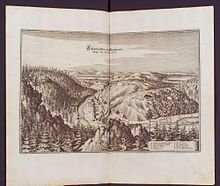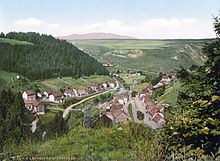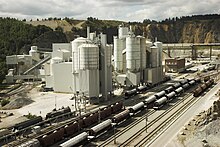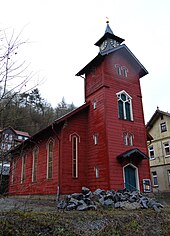Rübeland cave location
|
Rübeland cave location
City of Oberharz am Brocken
Coordinates: 51 ° 45 ′ 20 " N , 10 ° 50 ′ 48" E
|
|
|---|---|
| Residents : | 1400 (2011) |
| Incorporation : | January 1, 2004 |
| Incorporated into: | Elbingerode (Harz) |
| Postal code : | 38889 |
|
Location of the cave village Rübeland in Oberharz am Brocken
|
|
|
View of Rübeland from the Schornsteinberg
|
|
Rübeland is a village in the town of Oberharz am Brocken in the Harz district in Saxony-Anhalt . The village consists of the districts Höhlenort Rübeland, Susenburg and Neuwerk . Kaltes Tal and Kreuztal are also included. The place counts about 1400 inhabitants (2011).
Geographical location
Rübeland is located in the Harz low mountain range on the Bode . The Rübelandbahn and federal road 27 run through the village , from which a connecting road to federal road 81 branches off in the town center . The Rappbode dam extends south of the village . The subsoil of the area around Rübeland is made up of middle to Upper Devonian limestones of the Elbingerode complex , which come to light in cliffs in the area of the Bodetal.
Place name
The origin of the place name has not yet been clearly established; The following versions are common: Rovesland = Räuberland = Rübeland; Rovesland = rough land (climate) = Rübeland; Rovesland = rough country (concerning the human race) = Rübeland as well as combinations of these derivations.
Before its current name, the Birkenfeld region was probably named after the name of the castle of the same name (today's Birkenfeld castle ruins ).
history
Traces of hunters in the Paleolithic around 100,000 to 40,000 BC In the vicinity of the caves at Rübeland, artefacts such as stone tools and shards can be detected. The region was permanently settled from 714 onwards. Knight Werner von Birkenfeld owned the castle of the same name around 1134. The Elbingeroder Chronicle of 1320 mentions an iron ore works. In 1344 Count Albert and Bernhard von Regenstein were enfeoffed with the Stahlberg. The origin of the place Rübeland is dated in the 14th century. In 1436 a resident was named To dem Rouenlande . The increasing demand for wood as a raw material promoted the rafting on the Bode , which has been documented since 1536 .
The place in the former Duchy of Braunschweig-Lüneburg gained increasing popularity through the Baumannshöhle . The Harzer Sagenwelt attributes the discovery of the cave to a miner named Friedrich Baumann, who found it in search of ore deposits. A miner that name is not detectable and it is today that the year 1536 to this forecast in the era of National Socialism was fictitious, to come up with a suitable date for an anniversary celebration. The reputation of the natural wonder of the stalactite cave named after the legendary Baumann spread quickly and attracted visitors from near and far as early as the 16th century. The first cave tours were offered to residents, shepherds and forest workers from Rübeland who earned an extra income.
17th and 18th centuries

In the 17th century the Thirty Years War also affected the Harz. In 1626, the troops of Imperial General Tilly burned down Neuwerk. After the war, Rübeland experienced its first boom. In 1649, the Rübeländer Valentin Wagner and his family, who owned the house at today's Blankenburger Straße 37, were granted the privilege of official cave tours. This privilege, documented in a file from the Princely Archives Wolfenbüttel from 1668, was exercised by the Wagner family until they died out at the end of the 19th century. With the nature conservation decree for the Baumannshöhle, issued by Rudolf August , the first civil servant cave guide in the Harz was appointed in 1668.
The tourism to the Baumannshöhle steadily increased; Within a short time several descriptions of the cave were written. Around 1650, Matthäus Merian made an engraving of the place Rubelandt and the Buhmans Höhle ( Topographia Germaniae ). On April 10, 1668, Duke Rudolf August von Braunschweig-Lüneburg placed the Baumann Cave under his protection as the first stalactite cave in the world. In July 1672 a charcoal burner caused a forest fire on the Bielstein; Another cave - the Bielshöhle - was discovered during the clearance work. The Baumannshöhle was provided with a lockable door, steps, ladders and wooden bridges in 1688 on the initiative of the Wagner family. By 1700, five cave sections were already accessible and 33 display figures were identified.
In 1702 Professor Hardt drew the first cave plan, in 1703 Georg Henning Behrens published his travel description Hercynia Curiosa or Curiöser Hartz-Wald ... in which he raised the Baumann Cave to the “Queen of all caves” and mentioned many visitors. From 1717 industry also settled in Rübeland; Monks from the nearby Michaelstein Monastery operated a marble mill (closed in 1889) in Kreuztal; a sawmill and a powder mill (later a cardboard factory, closed in 1936) started operations. In 1788, regular tours also began in the smaller Bielshöhle.
The process of the 4 upper factors was also directed against the Rübeland smelter Johann Heinrich Walther in 1725.
19th century

Around 1800 the last wolf in the region was shot. In 1848 the Stauts´ house was built. This former farmhouse of the stud farm in the neighboring village of Hüttenrode was acquired by a Rübeland citizen after the end of horse breeding and the sale of the property. He took it down and rebuilt it in Burgstrasse, where it became known as the Office. The Rübeland village church was consecrated in 1868. In 1866 the road worker Wilhelm Angerstein discovered the Hermannshöhle .
The industrialization of the late 19th century required new transport routes; the Halberstadt-Blankenburg Railway also included Rübeland in its network - from November 1, 1885, the Harz Railway (now Rübelandbahn ) connected the town with Halberstadt and Tanne .
The observation pavilion on the Hohe Kleef was built in 1892. In 1896 Rübeland received another landmark through the bear sculpture on the heart cliff. In memory of the bones found by the cave bear ( Ursus spelaeus ) in the Hermannshöhle, the inscription reads The last of his tribe . The work of art made of reinforced concrete consists of six hollow parts, with a bottle with the names of the artists embedded in the base.
20th century

On January 10, 1918, there was a severe explosion in the Cramer & Buchholz powder mill on the Hahnenkopf, in which nine people were seriously injured, 30 to 40 were slightly and 14 were killed - the painter Käthe Evers was among those killed .
In 1928 the entrance area of the Baumannshöhle was redesigned and the museum opened.
The construction of the Rappbode dam began in 1938 , but was abandoned in 1942 because of the Second World War . During the war, numerous Soviet prisoners of war performed forced labor in the lime works. In the final phase of the Second World War, many people came to the Nordhausen area who backed away from the front approaching from the east.
Numerous wooden crosses in the Rübeland cemetery remind of Wehrmacht soldiers who died in April 1945 .
In the years 1948 to 1950, the bark beetle attacked the forests around Rübeland so severely that large areas of the spruce population had to be cleared. On July 1, 1950, the southeastern neighboring town of Neuwerk was incorporated into Rübeland. In order to protect the Eastern Harz from flooding and to ensure the supply of drinking water, the construction of the Rappbode dam was resumed; on September 1, 1952, the foundation stone of the dam was laid.
In 1952 and 1953, young people from Rübeland managed to uncover a completely littered mouth hole on Märtensstrasse (popularly known as Cameroon). As a result, they discovered a new natural cave , named after the person who discovered it, the Schmiedeknecht Cave . The most spectacular of all Rübeland stalagmites is located in the Berggeisthalle .
During the GDR era, a holiday camp was operated in the marble mill (or cross mill) in the Kreuz valley .
Since 1957, Susenburg, one kilometer away, has been a district of Rübeland. In the mid-1960s, the Rübelandbahn was expanded to create more transport capacity for the lime works; the steepest section overcomes a 6.2% gradient.
In 1999, Germany's first coalition of CDU and PDS began its work in Rübeland . On December 3, 2001, Bernhard Lange's home play "Die vom Rauhen Lande" was performed by the amateur theater group Rübeland as part of the Rübeland Cave Festival. The year 2004 brought changes in local politics. The name of the place was changed to "Höhlenort Rübeland" - an indication of the economic and tourist importance of the surrounding limestone caves. In addition, the unified municipality of Elbingerode (Harz) was formed, to which Elbingerode and Königshütte belong in addition to Rübeland . In the course of further municipal reforms, the town of Oberharz am Brocken was founded on January 1, 2010 , the district of which has been Rübeland cave since then.
The railway line from Blankenburg (Harz) via Rübeland to Tanne ( Rübelandbahn ) became particularly important in traffic engineering . It is only operated as far as Elbingerode (details here ).
In Rübeland there was a training facility of the People's Police , which carried out training and further education as well as simple exercises. The area was taken over by the Saxony-Anhalt police after the fall of the Wall in 1989 and operated until 2006 - until 2003 as an external property of the Saxony-Anhalt Police University . Today the object, which was abandoned in the course of police structural reforms, houses a guesthouse with a small police museum .
Postal services
For the development of the postal system in Rübeland, see: Braunschweig – Blankenburg postal route .
Rübeland in literature
"The gloomy beauty, the Bode, did not receive me so graciously, and when I first saw her in the forge-dark Rübeland, she seemed grumpy and covered herself in a silver-gray rain veil: but with quick love she threw it off when I got up the bustard reached me, her face shone towards me in sunniest splendor, a colossal tenderness breathed from every face, and from the conquered rock face it emerged like sighs of longing and melting sounds of melancholy. "
- - Heinrich Heine : The Harz Journey (1826)
"Soon the bare rock walls rose up on both sides, a narrow footpath ran along the narrow river bed, I was in Rübeland, a name that is derived from" Räuberland "because a robber's castle has always been on one of the rocks here, which has now disappeared except for the moats. "
- - Hans Christian Andersen : Travel Shadow (1831)
Memorials
- Soviet memorial in the local cemetery for 32 prisoners of war who were victims of forced labor
Sons and daughters of the place
- Carl Preen (1824–1889), social reformer and hut director
- Ferdinand Tiemann (1848–1899), chemist, synthesized vanillin
- Gustav Spengler (1913–1992), psychologist
- Rolf Fischer (1930–2013), major general in civil defense in the GDR
literature
- Christoph Unger: Rübeland. Harz jewel in the Bodetal . Publisher: Administration of the Rübeland stalactite caves. Wernigerode 1994
Web links
Individual evidence
- ^ Béatrice Austria: Geological hike around Rübeland . In: Friedhart Knolle , Béatrice Oesterreich, Rainer Schulz and Volker Wrede: The Harz - Geological Excursions . Perthes, Gotha 1997, ISBN 3-623-00659-9 , p. 164f.
- ^ Ernst Heinrich Kneschke: New general German nobility lexicon: Aa - Boyve . tape 1 . Voigt, 1859, p. 324 .
- ↑ Horst Scheffler, Hartmut Knappe: Coral, lime and dark cave. The Harz - a landscape introduces itself , issue 15/16, Harzmuseum Wernigerode 1986
- ↑ Friedrich Stolberg : The cave research in the Harz, a historical overview , messages from the Association of German Cave and Cave. Karstforscher, Heft 15, Munich 1969, online version
- ^ Karl-Heinz Grotjahn: Steel and turnips. Contributions and sources on the history of Lower Saxony in the First World War (1914–1918). CW Niemeyer 1993, p. 82, FN 130.
- ^ Report of the district director from Blankenburg to the ducal state ministry in Braunschweig from January 12, 1918. In: Karl-Heinz Grotjahn: Stahl und turnip. Contributions and sources on the history of Lower Saxony in the First World War (1914–1918). P. 70f.
- ↑ see Jens-Christian Wagner: Production of death: the Mittelbau-Dora concentration camp , Wallstein Verlag, Göttingen 2001, ISBN 3-89244-439-0 , page 274ff. E.g. Albert Speer's deputy Karl Saur relocated his office to Rübeland at the end of March 1945 (p. 276)





